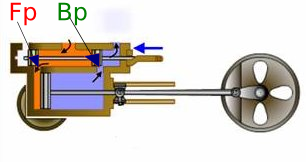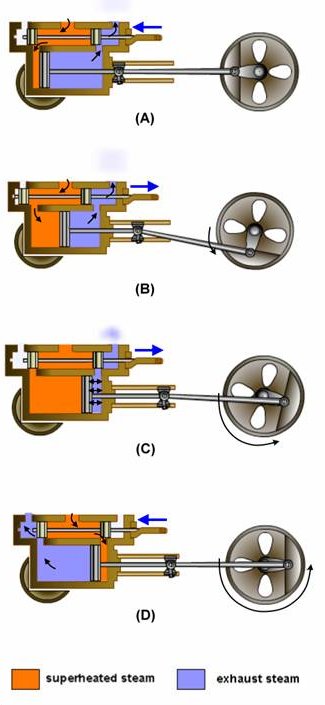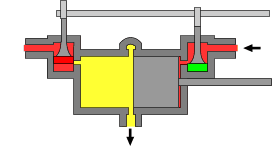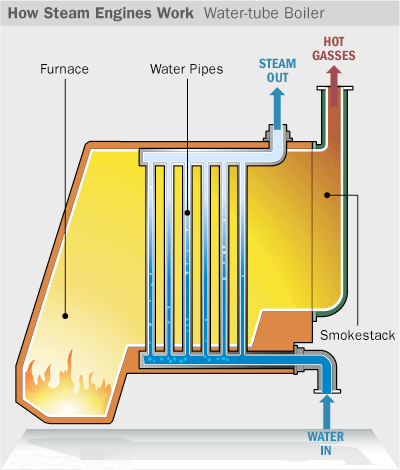Steam engine .
 A steam engine is a machine that produces mechanical work using steam. It needs a hot source to transform water into steam. On the left, a simple steam engine. There is an inlet valve ( in the middle ) and two Outlet valves.
A steam engine is a machine that produces mechanical work using steam. It needs a hot source to transform water into steam. On the left, a simple steam engine. There is an inlet valve ( in the middle ) and two Outlet valves.
Below this valves, there is a Fp ( front port ) and a Bp ( Back port) allow high-pressure steam to act alternately on both faces of the piston.
Phases in a Steam engine

Phase a ) The opening of the front port allows superheated steam from the boiler to enter the cylinder and push the piston back. As the piston move backwards, used steam from the previous stroke is exhausted through the back port.
Phase b). The valve starts to move backwards while the steam in the cylinder continues to expand and pushes the piston back.
Phase c) The front port opens to exhaust steam and at the same time the back port closes. This creates some back pressure before the next stroke is made.
Phase c) The back port opens to allow “fresh” steam into the cylinder which then push the piston forward. A new sweep begins again and the process repeats
As you may appreciate on Figure c, there is a brief time that both valves are close. The rest of time, the exhaust steam, just vents out into the air. It explains why old fashioned trains have to take on water from deposits from time to time.
 The intermittent realise of steam also explains the famous ” choo, choo, choo”. When the Fp or the Bp valve opens the steam exhaust escapes under a great pressure and makes a “choo!” sound. When Fp and Bp valves are closed, no steam is realise and no sound is produced. Later, the “choo” sound come back as a consequence of another pressured steam realise.
The intermittent realise of steam also explains the famous ” choo, choo, choo”. When the Fp or the Bp valve opens the steam exhaust escapes under a great pressure and makes a “choo!” sound. When Fp and Bp valves are closed, no steam is realise and no sound is produced. Later, the “choo” sound come back as a consequence of another pressured steam realise.
As faster the train moves, as more continuously the sound is.
The boiler
A boiler is a essential component in all type of steam engine. The high-pressure steam needed to move the piston in a steam engine comes from a boiler. Its job is to apply heat to water to create high-pressure steam.
The following diagram shows you a typical water-tube boiler. In this boiler, water flow through a rack of pipes that are placed in the path of hot gases from the fire.

Vents out : to release or discharge the steam
